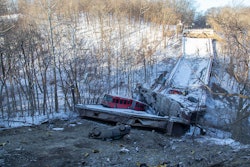
Caltrans has approved the use of low-carbon cement on road construction and maintenance projects.
The recently approved “Portland limestone cement” was developed through Caltrans-funded research at Oregon State University’s College of Engineering.
The research conducted by Jason Weiss, OSU professor of civil and construction engineering, determined that the Portland limestone cement would work as well as standard Portland cement in California but produce 10% less carbon-dioxide annually.
The carbon cutting comes in the way the limestone cement is produced. Portland cement typically requires mining, grinding, and heating limestone and clay to 2,820 degrees, according to Caltrans. The process alters the ingredients’ chemistry to create “clinker,” but it also produces a lot of carbon-dioxide, Weiss says. Clinker are rounded nodules that are ground into powder to make cement.
Instead, Weiss produced cement using about 15% more limestone than regular Portland cement to create less clinker, using less energy and reducing carbon emissions.
“Our goal is always to produce better, more sustainable and longer-lasting concrete,” Weiss said. “We don’t want to do research that sits in a book on a shelf. We want to impact standards, specifications and construction practices that move the civil and construction engineering profession forward.”
Based on his research, Caltrans developed new low-carbon cement standards. The agency estimates the reduced energy used to create the limestone cement will make its costs about the same or slightly less than regular Portland cement.
Caltrans noted that in 2017 it used 325,000 tons of cement to upgrade the state highway system. “Switching to low-carbon cement has the potential to reduce carbon-dioxide emissions by 28,000 tons a year – the equivalent of removing more than 6,000 cars off the road,” the agency says. “Using low-carbon cement can cut Caltrans’ concrete-related carbon-dioxide emissions annually by up to 10 percent,” adds Caltrans Director Toks Omishakin. “This is a big step in supporting California’s efforts to achieve carbon neutrality by 2045.”
In creating the standards, Caltrans says it worked with the California Air Resources Board and industry experts and stakeholders, including the California Construction and Industrial Materials Association and the California Nevada Cement Association. Caltrans says it will continue to work with the California Air Resources Board to reach the state’s goal of net-zero emissions from the cement sector by 2045.











